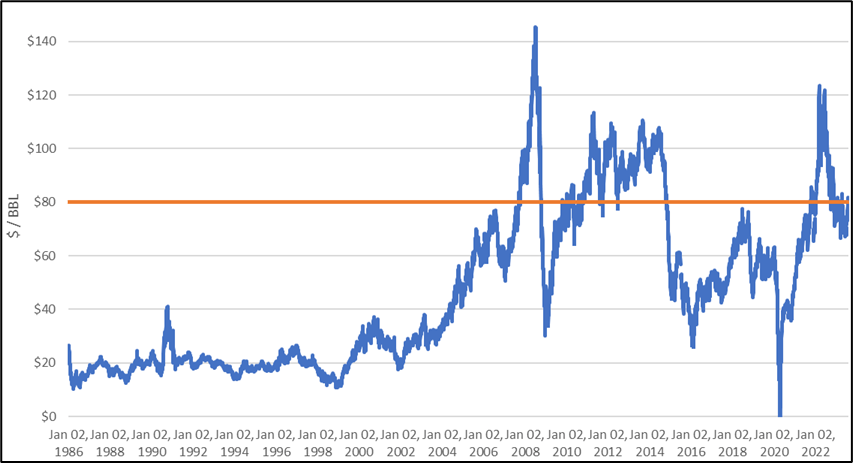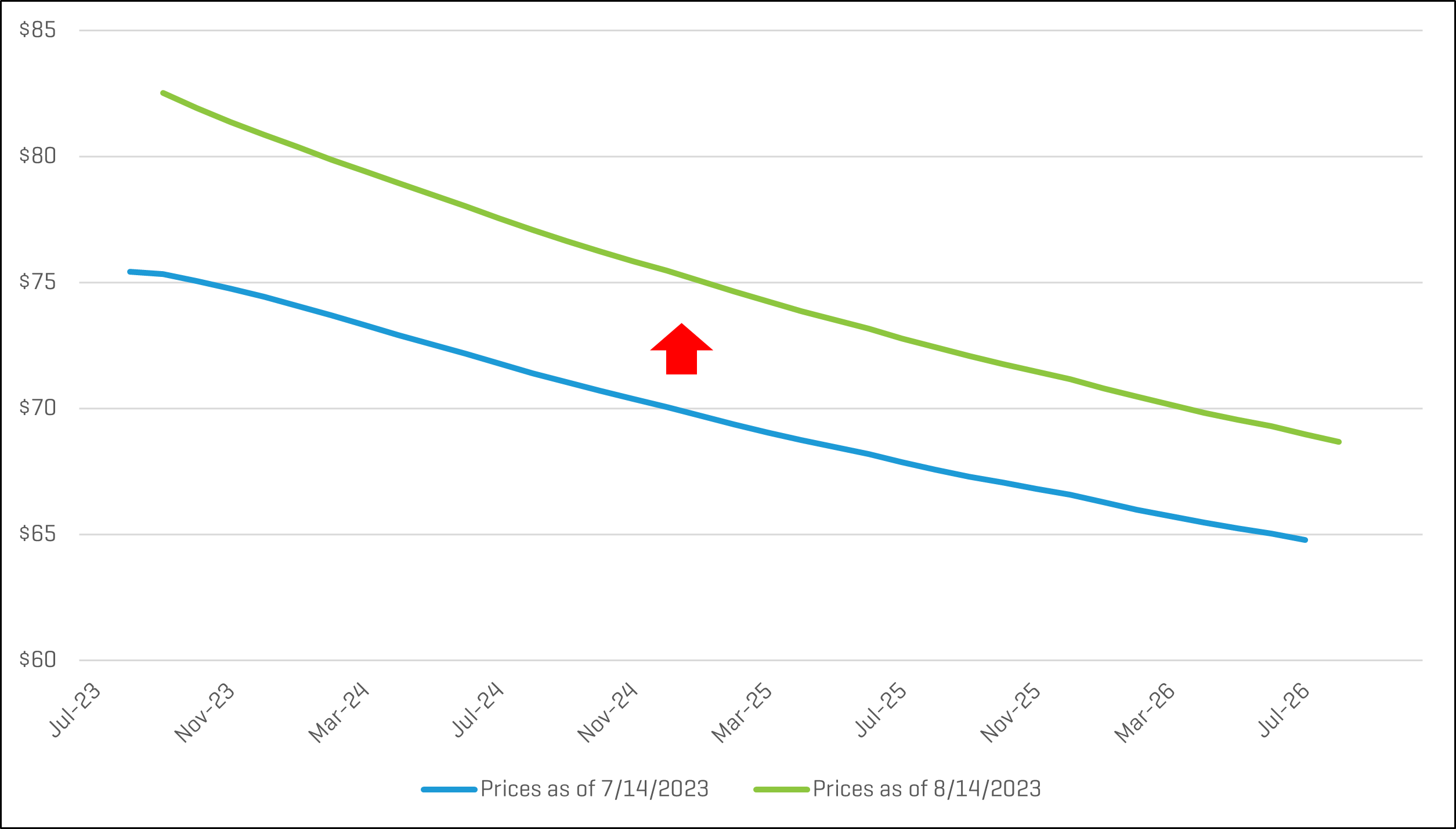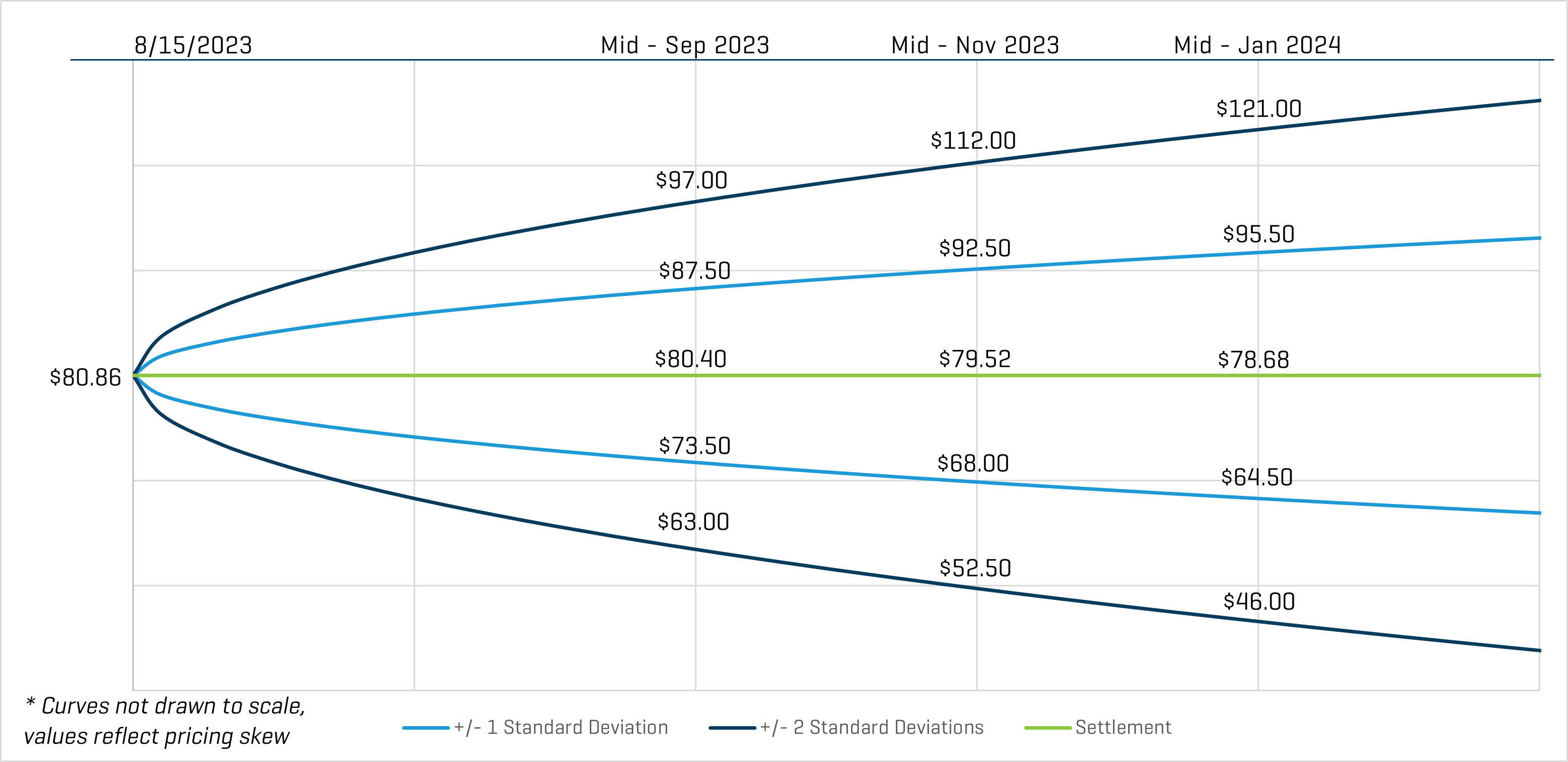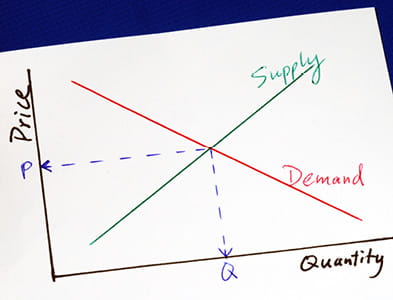Oil Prices Go Back to the 80s (in Dollars Per Barrel, That Is)
Oil Prices Go Back to the 80s (in Dollars Per Barrel, That Is)
Spot Prices for Oil
Prices for oil (West Texas Intermediate Crude or “WTI”) in the U.S. recently increased above $80 per barrel again, which has only happened a few times in U.S. history. The WTI crude oil price represents the cost of a barrel of oil produced in the U.S. as measured at a pipeline exchange point in Cushing, Oklahoma. It serves as a benchmark for pricing oil in North America and is a vital reference point for both domestic and international oil markets. Numerous factors can influence the price of WTI oil, such as global demand and supply dynamics, geopolitical tensions, weather events, and economic growth prospects.
The chart below shows historical oil prices as reported on the EIA’s website.1

Inflationary Impacts
While benefiting oil companies and related industries, this increase comes at a problematic time for the rest of the country, as the Federal Reserve recently proved that it is not done with increasing interest rates to bring down inflation, currently at 3%, with the Fed’s target being a 2% annual rate.
For comparison, inflation in May 2023 was at a 4% rate, and the June 2023 increase was the smallest 12-month increase since March 2021. A year earlier, in June 2022, the 12-month increase in overall prices was 9.1% and had been 7.0% or higher in the preceding six months.2
The price of oil contributes to the U.S. inflation rate in a number of ways. First, oil is a major input cost for many businesses, so higher oil prices can lead to higher production costs. When passed on to consumers in the form of higher prices for goods and services, this increases inflation.
Second, oil is a major component of transportation costs for the entire supply chain. When oil prices are high, it becomes more expensive to transport goods and services, which can also lead to higher prices for consumers, and higher inflation.
Third, oil is the major component of energy costs. When oil prices are high, it becomes more expensive to heat and/or cool homes and businesses, which can also lead to higher prices for consumers.
According to the Federal Reserve, a rule of thumb is that every $10 per barrel increase in the price of crude oil raises inflation by 0.2% and sets back economic growth 0.1%. This means that if the price of oil were to increase by $100 per barrel, it could potentially lead to an inflation rate of 2% and a 1% decline in economic growth.3
Outlook and Circularity
Looking ahead and considering the market clearing prices for oil and gas futures, the markets expect oil prices to fall from this current level and return to a level around $74 per barrel. This decline will help with keeping inflation down, leading to potentially lower future interest rates. This could increase demand for goods and services, leading to greater global demand for oil-related products, thus increasing the cost of oil.
This economic circularity is one of the key challenges facing the Federal reserve currently as it tries to calm the current levels of inflation in the U.S.
WTI Strip Prices Increase
Spot prices and futures prices for the West Texas Intermediate (WTI) contract increased by approximately $7.00 per barrel in the near term and increased approximately $4.00 over the longer term.
WTI Strip Prices - One Month Change

As shown, the oil price curve remains in a state of “backwardation,” reflecting the market’s expectation of lower future spot prices.
Oil Price Outlook
The price distribution below shows the crude oil spot price on August 15, 2023, as well as the predicted crude oil prices based on options and futures markets. Light blue lines are within one standard deviation (σ) of the mean, and dark blue lines are within two standard deviations.
WTI Crude Oil $/BBL

Based on these current prices, the markets indicate there is a 68% chance oil prices will range from $68.00 and $92.50 per barrel in mid-November 2023. Likewise, there is roughly a 95% chance that prices will be between $52.50 and $112.00. By mid-January 2024, the one-standard deviation (1σ) price range is $64.50 to $95.50 per barrel, and the two-standard deviation (2σ) range is $46.00 to $121.00 per barrel.
Key Takeaways
Remember that option prices and models reflect expected probabilities, not certain outcomes, but that does not make them any less useful. So far in 2023, crude oil prices have primarily remained within the range of $70 to $80 per barrel. As such, we have seen volatility decrease significantly compared to 2022, which is evidenced by the futures price ranges observed. For mid-January 2024 pricing as of August 15, 2023, the 1σ range had a spread of $31.00 per barrel, and the 2σ range has a spread of $75.00 per barrel. For comparison, in 2022 we observed 1σ and 2σ price ranges in excess of $65.00 and $150.00, respectively.
- Cushing, OK WTI Spot Price, U.S. Energy Information Administration.
- “Consumer prices up 3.0 percent over the year ended June 2023,” TED: The Economics Daily, U.S. Bureau of Labor Statistics, July 17, 2023.
- “What Is the Relationship Between Oil Prices and Inflation?” Nick Lioudis, Investopedia, May 5, 2022.




